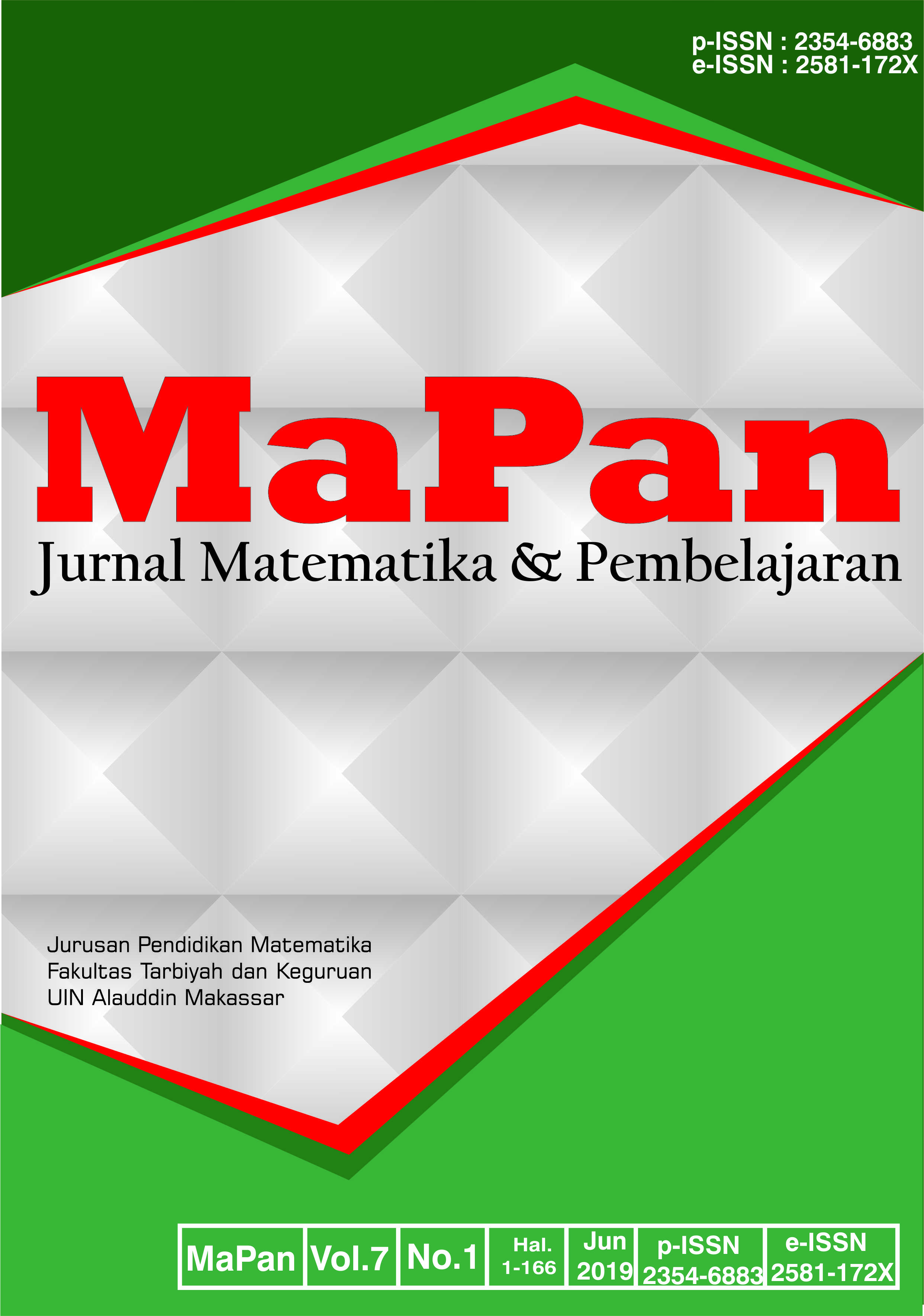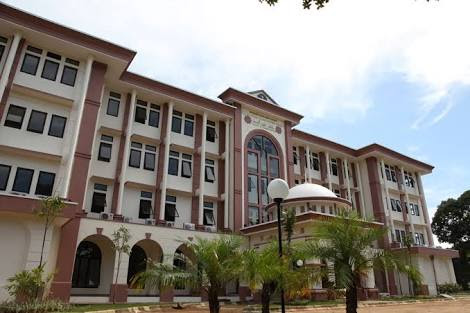PENILAIAN SELF EFFICACY DAN KEMAMPUAN PEMECAHAN MASALAH MATEMATIKA BERDASARKAN PERSPEKTIF GENDER
Abstract
Abstrak:
Penelitian ini bertujuan untuk mengetahui apakah ada perbedaan penilaian self efficacy dan kemampuan pemecahan masalah matematika berdasarkan perspektif gender. Penelitian ini merupakan penelitian kuantitatif dengan menggunakan desain kausal komparatif. Teknik pengambilan sampel menggunakan purposive sampling dengan subyek penelitian ini adalah kelas X IPA/MIA MAN 3 Cirebon dengan jumlah sampel 60 siswa dengan kategori gender yaitu siswa laki-laki sebanyak 30 siswa dan siswa perempuan sebanyak 30 siswa. Instrumen dalam penelitian ini adalah angket untuk mengukur self efficacy siswa dan tes untuk mengukur kemampuan pemecahan masalah matematika. Hasil penelitian ini menunjukkan bahwa angket self efficacy siswa dengan rata-rata sebesar 70,66 atau 71% dengan kategori baik dan kuat. Siswa laki-laki memperoleh nilai rata-rata 68,04 dengan persentase 67% dan siswa perempuan memperoleh nilai rata-rata 73,46 dengan persentase 73%. Terdapat perbedaan self efficacy siswa berdasarkan nilai rata-rata dengan nilai signifikan 0,023 < 0,05. Kemampuan pemecahan masalah matematika siswa MAN 3 Cirebon mempunyai rata-rata sebesar 61,30 dalam kategori sedang. Siswa laki-laki memperoleh kemampuan pemecahan masalah matematika dengan rata-rata 55,60 sedangkan siswa perempuan memperoleh rata-rata kemampuan pemecahan masalah matematika 67,00. Oleh karena itu perbedaan dari rata-rata yang diperoleh siswa dengan nilai signifikan 0,001 < 0,005. Hal ini dapat dikatakan adanya perbedaan penilaian self efficacy dan kemampuan pemecahan masalah matematika berdasarkan perspektif gender yang signifikan (nyata).
Abstract:
This study intended to determine whether there were differences in self-efficacy and the ability in solving mathematical problems based on a gender perspective. This research was a quantitative study using a comparative causal design. The sampling technique used purposive sampling with the subjects of this study were class X IPA/MIA MAN 3 Cirebon with a sample of 60 students with gender categories namely 30 male students and 30 female students. The instrument in this study was a questionnaire to measure students' self-efficacy and tests to measure mathematical problem-solving abilities. The results of this study indicated that the self-efficacy questionnaire of students with an average of 70.66 or 71% in the category of good or strong. Male students obtained an average score of 68.04 with a percentage of 67% and female students obtained an average score of 73.46 with a percentage of 73%. There were differences in self-efficacy of students based on the average value with a significant value of 0.023 <0.05. Mathematical problem-solving abilities of students MAN 3 Cirebon has an average of 61.30 in the medium category. Male students obtain mathematical problem-solving abilities with an average of 55.60 while female students obtain an average mathematical problem-solving ability of 67.00. there are differences from the average obtained by students and with a significant value of 0.001 <0.005. It can be said that there is a difference in self-efficacy and the ability to solve mathematical problems based on a significant gender perspective.
Downloads
References
Bandura, A. (2010). Self‐efficacy, The Corsini encyclopedia of psychology. Wiley Online Library. Retrieved from https://doi.org/10.1002/9780470479216.corpsy0836
Cialdini, R. B. (1980). Full-cycle Social Psychology. Applied Social Psychology Annual, 1, 21–47. Retrieved from https://psycnet.apa.org/record/1981-23592-001
Csikszentmihalyi, M., & Larson, R. (2014). Validity and Reliability of the Experience-Sampling Method. Springer Link, 175(9), 526–536. Retrieved from https://link.springer.com/chapter/10.1007/978-94-017-9088-8_3
Dominowski, R. L. (2002). Teaching Undergraduates. New Jersey: Lawrence Erlbaum Assosiates Publisher.
Etikan, I., Musa, S. A., & Alkassim, R. S. (2016). Comparison of Convenience Sampling and Purposive Sampling. American Journal of Theoretical and Applied Atatistics, 5(1), 1–4. Retrieved from http://www.sciencepublishinggroup.com/journal/paperinfo?journalid=146&doi=10.11648/j.ajtas.20160501.11
Fatonah, S. (2017). Pengaruh Self efficacy dan Sel Regulated Prestasi Belajar Matematika Siswa Kelas VIII di SMP Negeri 1 Cidahu Kab. Kuningan. IAIN Syekh Nurjati Cirebon.
Feist, J., & Feist, G. J. (2008). Theories of Personality (7th ed.). Retrieved from http://www.primisonline.com/
Freudenthal, H. (2012). Mathematics as An Educational Task (Springer Science & Business Media, Ed.). Springer Science & Business Media.
Garrison, D. R. (1991). Critical thinking and adult education: A conceptual model for developing critical thinking in adult learners. International Journal of Lifelong Education, 10(4), 287–303. Retrieved from https://www.researchgate.net/publication/240528387_Critical_thinking_and_adult_education_A_conceptual_model_for_developing_critical_thinking_in_adult_learners
Hakim, A. R. (2017). Prestasi Belajar Matematika Ditinjau dari Sikap dan Komitmen Diri Peserta Didik pada Pelajaran Matematika. JKPM (Jurnal Kajian Pendidikan Matematika), 2(1), 24–36. Retrieved from https://journal.lppmunindra.ac.id/index.php/jkpm/article/view/1892
Halonen, J. S., & Santrock, J. W. (1999). Psychology Contexts & Applications. In McGraw-Hill. Retrieved from https://www.coursehero.com/file/p2ul1jm/REQUIRED-TEXT-Halonen-JS-Santrock-JW-1999-Psychology-Contexts-applications-3rd/
Hartono, D. R. (2017). Pengaruh Self Efficacy (Efikasi Diri) Terhadap Tingkat Kecemasan Mahasiswa Fakultas Kedokteran Universitas Sebelas Maret. Universitas Sebelas Maret. Dari.
Heller, P., Keith, R., & Anderson, S. (1992). Teaching Problem Solving Through Cooperative Grouping. Part 1: Group versus Individual Problem Solving. American Journal of Physics, 60(7), 627–636. Retrieved from https://www.google.com/url?sa=t&rct=j&q=&esrc=s&source=web&cd=1&ved=2ahUKEwiS1Zvum4njAhWLro8KHeaCC5sQFjAAegQIABAC&url=https%3A%2F%2Fd1b10bmlvqabco.cloudfront.net%2Fattach%2Fi5li1rs55o12sy%2Fhsg4ulhusig4id%2Fi6cjt6dficgt%2FHelleretal_92_AJP.pdf&usg=AOvVaw1
Kinicki, A., & Kreitner, R. (2006). Organizational Behavior: Key Concepts, Skills & Best Practices. Columbus: OH: McGraw-Hill/Irwin.
Lee, E., & Hannafin, M. J. (2016). A design Framework for Enhancing Engagement in Student-centered Learning: Own it, Learn it, and Share it. Educational Technology Research and Development, 64(4), 707–734. Retrieved from https://link.springer.com/article/10.1007/s11423-015-9422-5
Lishinski, A., Yadav, A., Good, J., & Enbody, R. (2016). Learning to program: Gender differences and interactive effects of students’ motivation, goals, and self-efficacy on performance. In Proceedings of the 2016 ACM Conference on International Computing Education Research. Retrieved from https://dl.acm.org/citation.cfm?id=2960329
Maksum, A. (2017). Sosiologi Pendidikan. Malang: Madani.
Nugrahani, R. (2013). Hubungan Self-Efficacy dan Motivasi Belajar dengan Kemandirian Belajar Siswa Kelas V SD Negeri se-Kecamatan Danurejan, Yogyakarta. FIP UNY [Fakultas Ilmu Pendidikan, Universitas Negeri Yogyakarta].
Pease, A., & Pease, B. (2017). Why Men Don’t Listen & Women Can’t Read Maps: How to Spot the Differences in The Way Men & Women Think. Retrieved from https://www.bookdepository.com/Why-Men-Dont-Listen-Women-Cant-Read-Maps-Allan-Pease/9781409168515
Phillips J. M., & Gully, S. M. (1997). Role of Goal Orientation, Ability, Need for Achievement, and Locus of Control in the Self-efficacy and Goal--Setting Process. Journal of Applied Psychology, 82(5), 792–802. Retrieved from https://www.google.com/url?sa=t&rct=j&q=&esrc=s&source=web&cd=1&cad=rja&uact=8&ved=2ahUKEwjFnPWi-orjAhWJPo8KHc7SA_AQFjAAegQIAhAB&url=http%3A%2F%2Fpsycnet.apa.org%2Frecord%2F1997-30049-015&usg=AOvVaw2kOdlP8iJqFK7_ausdPTUz
Polya, G. (2004). How to solve it: A New Aspect of Mathematical Method. Retrieved from https://press.princeton.edu/titles/669.html
Riani, W. S., & Rozali, Y. A. (2014). Hubungan Antara Self Efficacy dan Kecemasan Saat Presentasi pada Mahasiswa Univeristas Esa Unggul. Jurnal Psikologi Esa Unggul, 12(1), 1–9. Retrieved from https://www.neliti.com/id/publications/126836/hubungan-antara-self-efficacy-dan-kecemasan-saat-presentasi-pada-mahasiswa-unive
Risnawita, R., & Ghufron, M. N. (2014). Teori-teori psikologi. Jakarta: Ar-Ruzz Media.
Schoenfeld, A. (1992). Learning to Think Mathematically: Problem Solving, Metacognition, and Sense-making in Mathematics. Learning from Instraction, 334–370. Retrieved from https://www.researchgate.net/publication/289963462_Learning_to_think_mathematically_Problem_solving_metacognition_and_sense_making_in_mathematics/download
Skaalvik, E. M., Federici, R. A., & Klassen, R. M. (2015). Mathematics Achievement and Self-efficacy: Relations with Motivation for Mathematics. International Journal of Educational Research, 72, 129–136. Retrieved from https://doi.org/10.1016/j.ijer.2015.06.008
Van de Vijver, F., & Leung, K. (1997). Methods and Data Analysis of Comparative Research (Vol. 1). Retrieved from https://research.tilburguniversity.edu/en/publications/methods-and-data-analysis-of-comparative-research
Wardhani, S. (2008). Analisis SI dan SKL Mata Pelajaran Matematika SMP/MTs untuk Optimalisasi Tujuan Mata Pelajaran Matematika. Yogyakarta: PPPPTK.
Winarso, W. (2014). Membangun Kemampuan Berfikir Matematika Tingkat Tinggi Melalui Pendekatan Induktif, Deduktif dan Induktif-Deduktif dalam Pembelajaran Matematika. Eduma: Mathematics Education Learning and Teaching, 3(2), 95–118. Retrieved from http://www.syekhnurjati.ac.id/jurnal/index.php/eduma/article/view/58
Copyright (c) 2019 Winda Yuliana, Widodo Winarso

This work is licensed under a Creative Commons Attribution 4.0 International License.


